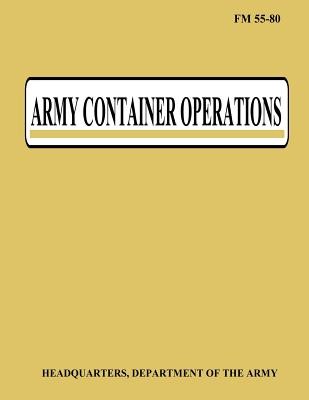
- We will send in 10–14 business days.
- Author: Department of the Army
- Publisher: CreateSpace Independent Publishing Platform
- Year: 2012
- Pages: 156
- ISBN-10: 1480236616
- ISBN-13: 9781480236615
- Format: 21.6 x 28 x 0.8 cm, softcover
- Language: English
- SAVE -10% with code: EXTRA
Reviews
Description
This manual, "Army Container Operations," has been prepared by the USACASCOM as a consolidated container reference incorporating policy, doctrine, and procedures needed to conduct container operations across the range of military operations. Existing Army policies and doctrine relating to intermodal containerization date back to 1975. Publications are being revised in view of lessons learned from operations in the Persian Gulf, Somalia, Haiti, Bosnia, and other conflicts. The transition from a forward deployed Army to a CONUS-stationed force demands new approaches to operations. Improving force projection depends on maximizing strategic lift, improving force closure, and updating doctrine which incorporate new ways of doing business. Army units should consult this Field Manual when conducting intermodal container operations. The DOD relies on commercial sealift to move 85 percent of cargo during contingency operations. The US and world merchant fleets are dominated by large, fast containerships with supporting corporate infrastructure. Experience in ODS revealed that DOD was unprepared to use effectively, containers and containerships to move UE and ammunition. This contributed, in conjunction with port saturation and lack of ITV, to the slow deployment of CS/CSS forces and resulted in significant delays in moving Class V resupply. Also large numbers of small, slow breakbulk vessels were used instead of containerships which resulted in significant costs in time and money. This manual provides guidance for container users who ship commodities within the DOD intermodal container system. The DOD system includes intermodal containers and container services, either DOD-owned or leased, or commercially provided. It also includes other ANSI/ISO configured equipment held by DOD activities before, during, and after intermodal shipment in the DTS.
EXTRA 10 % discount with code: EXTRA
The promotion ends in 20d.20:12:42
The discount code is valid when purchasing from 10 €. Discounts do not stack.
- Author: Department of the Army
- Publisher: CreateSpace Independent Publishing Platform
- Year: 2012
- Pages: 156
- ISBN-10: 1480236616
- ISBN-13: 9781480236615
- Format: 21.6 x 28 x 0.8 cm, softcover
- Language: English English
This manual, "Army Container Operations," has been prepared by the USACASCOM as a consolidated container reference incorporating policy, doctrine, and procedures needed to conduct container operations across the range of military operations. Existing Army policies and doctrine relating to intermodal containerization date back to 1975. Publications are being revised in view of lessons learned from operations in the Persian Gulf, Somalia, Haiti, Bosnia, and other conflicts. The transition from a forward deployed Army to a CONUS-stationed force demands new approaches to operations. Improving force projection depends on maximizing strategic lift, improving force closure, and updating doctrine which incorporate new ways of doing business. Army units should consult this Field Manual when conducting intermodal container operations. The DOD relies on commercial sealift to move 85 percent of cargo during contingency operations. The US and world merchant fleets are dominated by large, fast containerships with supporting corporate infrastructure. Experience in ODS revealed that DOD was unprepared to use effectively, containers and containerships to move UE and ammunition. This contributed, in conjunction with port saturation and lack of ITV, to the slow deployment of CS/CSS forces and resulted in significant delays in moving Class V resupply. Also large numbers of small, slow breakbulk vessels were used instead of containerships which resulted in significant costs in time and money. This manual provides guidance for container users who ship commodities within the DOD intermodal container system. The DOD system includes intermodal containers and container services, either DOD-owned or leased, or commercially provided. It also includes other ANSI/ISO configured equipment held by DOD activities before, during, and after intermodal shipment in the DTS.


Reviews